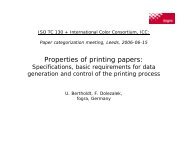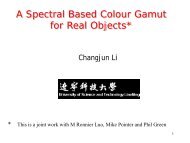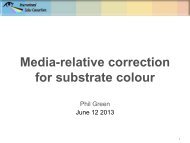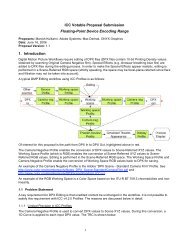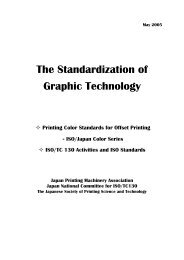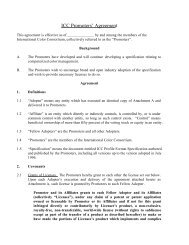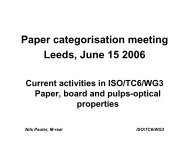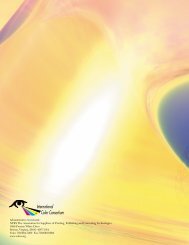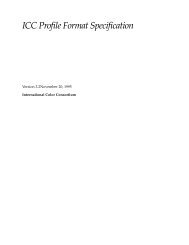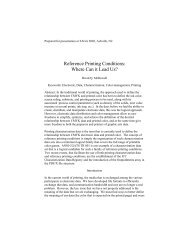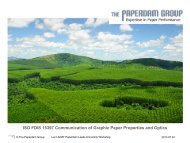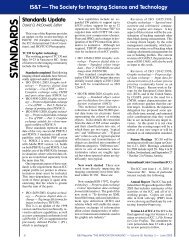ISO TC130 meetings in Paris - International Color Consortium
ISO TC130 meetings in Paris - International Color Consortium
ISO TC130 meetings in Paris - International Color Consortium
You also want an ePaper? Increase the reach of your titles
YUMPU automatically turns print PDFs into web optimized ePapers that Google loves.
Vol. 23 No. 3—May/June 2008<br />
www.imag<strong>in</strong>g.org<br />
STANDARDS UPDATE<br />
David Q. McDowell, Editor<br />
The March-April issue of the standards<br />
update focused on a seri es of related<br />
standards that are be<strong>in</strong>g revised jo<strong>in</strong>tly<br />
by <strong>ISO</strong> <strong>TC130</strong> (Graphic technology)<br />
and <strong>ISO</strong> TC42 (Photography). The three<br />
standards <strong>in</strong>volved were: <strong>ISO</strong> 5 (Photography<br />
and graphic technology—<strong>ISO</strong> standard<br />
density measurements); <strong>ISO</strong> 3664<br />
(View<strong>in</strong>g conditions—Graphic technology<br />
and photography); and <strong>ISO</strong> 13655<br />
(Graphic technology — Spectral measurement<br />
and colorimetric co mputation fo r<br />
graphic arts images).<br />
In this issue I will review some of the<br />
other work acco mplished at the recent<br />
Work<strong>in</strong>g Group <strong>meet<strong>in</strong>gs</strong> of <strong>TC130</strong> held<br />
<strong>in</strong> <strong>Paris</strong> April 14 – 19, 2008.<br />
A Rem<strong>in</strong>der – <strong>TC130</strong> Organization<br />
To help you understand the various<br />
activities, and who does what to whom, a<br />
brief remi nder of the organi z ation of<br />
<strong>TC130</strong> is appropriate. Some <strong>ISO</strong> committees<br />
organi ze themselves as Sub -<br />
Committees (SC) which may or may not<br />
have Work<strong>in</strong>g Groups (WG) with<strong>in</strong> the<br />
sub-committees. Others, like <strong>TC130</strong> simply<br />
are organized by Work<strong>in</strong>g Groups.<br />
Further, when work <strong>in</strong>volves more<br />
that one <strong>ISO</strong> TC, a joi nt activity is<br />
permitted and such jo<strong>in</strong>t acti vities are<br />
usually identi fied as a Joi nt Worki ng<br />
Group or JWG. However, even though a<br />
J WG <strong>in</strong>volves technical ex perts from<br />
more than one TC, it is under the supervision<br />
of one parent Technical Committee.<br />
Cu rrently, <strong>TC130</strong> has five active<br />
WGs , is responsible for four JWGs and<br />
participates <strong>in</strong> four additional JWGs adm<strong>in</strong>istered<br />
by other TCs. The l<strong>in</strong>eup is as<br />
follows:<br />
• WG 1 Term<strong>in</strong>ology<br />
• WG 2 Prepress data exchange<br />
• WG 3 Process control and related<br />
metrology<br />
• WG 4 Media and materials<br />
• WG 5 Ergonomics—Safety<br />
• JWG 6 (Jo<strong>in</strong>t TC 130-TC 42 WG):<br />
Certified reference materials—<br />
STANDBY<br />
• JWG 7 (Jo<strong>in</strong>t TC 130, TC42, and<br />
ICC WG) Colour management.<br />
Ma<strong>in</strong>tenance of <strong>ISO</strong> version of ICC<br />
specification—<strong>ISO</strong> 15076.<br />
• JWG 8 (Jo<strong>in</strong>t TC 130-TC 42 WG):<br />
Revision of <strong>ISO</strong> 13655<br />
• JWG 9 (Jo<strong>in</strong>t TC 130-TC 42 WG):<br />
Development of <strong>ISO</strong> 12640-5<br />
The JWGs <strong>in</strong> which <strong>TC130</strong> participates<br />
that are adm<strong>in</strong>istered by others are:<br />
• TC 42/WG 21, Jo<strong>in</strong>t TC 42-TC 130<br />
WG: Density measurements<br />
(Revision of <strong>ISO</strong> 5 series)<br />
• TC 42/JWG 22 Jo<strong>in</strong>t IEC/TC 100-<br />
<strong>ISO</strong>/TC 42-TC 130 WG : Colour<br />
management<br />
• TC 42/WG 23 Jo<strong>in</strong>t TC 42-TC 130-<br />
CIE WG: Extended colour encod<strong>in</strong>gs<br />
for digital image storage, manipulation<br />
and <strong>in</strong>terchange<br />
• TC 42/WG 24 Jo<strong>in</strong>t TC 42-TC 130<br />
WG: View<strong>in</strong>g standards (Revision of<br />
<strong>ISO</strong> 3664)<br />
• TC 171/SC 2/WG 5 Jo<strong>in</strong>t TC 171/SC<br />
2—TC 42—TC 46/SC 11—TC 130<br />
WG: Document management<br />
applications—Application issues PDF/A<br />
A lot of <strong>in</strong>terlocked activity and a lot<br />
of coord<strong>in</strong>ation between committees, but<br />
also an excit<strong>in</strong>g program that is clearly<br />
chang<strong>in</strong>g the <strong>in</strong>dustry.<br />
Some of the progress<br />
For the sake of simplicity we will look at<br />
the activities by work<strong>in</strong>g group.<br />
WG 1 Term<strong>in</strong>ology<br />
WG1 currently is focused on two do cuments.<br />
The multi - part <strong>ISO</strong> 12637,<br />
Gr aphic technology — Vocabulary and<br />
<strong>ISO</strong> 5776 Graphic Technology—Symbols<br />
for text correction.<br />
At this meet<strong>in</strong>g the f<strong>in</strong>al resolution<br />
of comments was completed on the DIS<br />
ballots of <strong>ISO</strong> 12637 Part 2: Prepress<br />
terms, and Part 3: Pr<strong>in</strong>t<strong>in</strong>g terms and<br />
these will now go forward for FDIS ballot.<br />
Plann<strong>in</strong>g work was started on a revisio n<br />
of Part 1: Fundamental terms.<br />
Work on the update of <strong>ISO</strong> 5776<br />
is mov<strong>in</strong>g forward slowly because WG1<br />
is attempt<strong>in</strong>g to <strong>in</strong>clude correction marks<br />
for both alphabe tic and logogr aphic<br />
systems. A p roof-correction committee<br />
with 13 members has been set up<br />
<strong>in</strong> Beij<strong>in</strong>g with the aim of establish<strong>in</strong>g<br />
S<strong>in</strong>o-Japanese standard correction marks<br />
for use <strong>in</strong> both language areas. It is<br />
understood t hat agreement may not be<br />
reached b etween Ch<strong>in</strong>a a nd Japan on<br />
all correction marks but that all marks<br />
will be shown <strong>in</strong> se par ate colu mns.<br />
Attempts to make contact with experts <strong>in</strong><br />
Korea had n ot be en successful, b ut it<br />
is hoped that they wi ll jo<strong>in</strong> <strong>in</strong> talks on<br />
harmonization.<br />
WG 2 Prepress data exchange<br />
WG2 has a variety of activit ies that are<br />
underway or recently completed.<br />
The tw o latest vers ions of PDF/X<br />
have been publ ished. There are <strong>ISO</strong><br />
15930-7, Graphic tech nology—Prepress<br />
digital data exchange us<strong>in</strong>g PDF—Part 7:<br />
Comple te exchange of pri nti ng data<br />
(PDF/X-4) and partial exchange of pr<strong>in</strong>t<strong>in</strong>g<br />
data with extern al profile reference<br />
( PDF/X-4p) usi ng PDF 1.6 and <strong>ISO</strong><br />
15930-8, Graphic tech nology—Prepress<br />
digital data exchange us<strong>in</strong>g PDF—Part 8:<br />
Partial exchange of pr<strong>in</strong>t<strong>in</strong>g data us<strong>in</strong>g<br />
PDF 1.6 (PDF/X-5). (See IS&T Reporter<br />
Vol. 23 No. 1, January/February 2008 for<br />
more detail)<br />
Work is well underw ay on <strong>ISO</strong><br />
16612-2 Gr aphic technology — Variable<br />
data exchange—Part 2: Us<strong>in</strong>g PDF/X-4<br />
and PDF/X-5 (PDF/VT-1 and PDF/VT-<br />
2). (This is a modified title for this standard<br />
and VT stands for "variable" and<br />
" tr ansactional" data). The work on<br />
PDF/VT is be<strong>in</strong>g done by Task Force 3<br />
(TF3) with<strong>in</strong> WG2. One of their major<br />
struggles is to identify the structural elements<br />
with<strong>in</strong> the basic PDF specification<br />
that will support the needs of the variable<br />
4<br />
IS&T Reporter
www.imag<strong>in</strong>g.org<br />
Vol. 23 No. 3—May/June 2008<br />
data pr<strong>in</strong>t<strong>in</strong>g marketplace. This is trul y<br />
an emergi ng market and TF3 is<br />
develop<strong>in</strong>g the open <strong>in</strong>terfaces and data<br />
structures that will be needed as this segment<br />
of the pr<strong>in</strong>t<strong>in</strong>g market develops.<br />
As mentioned <strong>in</strong> the January-February<br />
issue of the Re porter, Adobe has<br />
placed the PDF file format <strong>in</strong> the sta n-<br />
dards doma<strong>in</strong> and PDF 1.7 has been approved<br />
as <strong>ISO</strong> 32000-1. TC 171/SC 2/<br />
WG 7 is responsible for the support and<br />
ma<strong>in</strong>tenance of <strong>ISO</strong> 32000 and is actively<br />
review<strong>in</strong>g proposals for <strong>in</strong>clusion <strong>in</strong> the<br />
next draft. <strong>TC130</strong>/WG2/TF3 is prepar<strong>in</strong>g<br />
a number of proposals for consideration<br />
by TC 171/SC 2/ WG 7 for the next version<br />
of <strong>ISO</strong> 32000. If these are accepted<br />
it will si mpl i fy the pre par ation of<br />
PDF/VT and more easily allow it to be<br />
a valid subset of PDF.<br />
WG2 is also prepar<strong>in</strong>g <strong>ISO</strong> 12640-4,<br />
Gr aphic technology — Pre press digital<br />
data exchange—Part 4: Wide gamut display-referred<br />
standard colour image data<br />
(TBDencoded/SCID). It is expected that<br />
the encod<strong>in</strong>g will be Adobe RGB (1998).<br />
This st andard consists of reference<br />
test images where the image data is the<br />
normative part of the standard. The images<br />
of Part 4 will supplement the images<br />
of Part 1 (CMYK da ta), Part 2 (sRGB<br />
gamut images), and Part 3 (large gamut<br />
images encoded as CIELAB data).<br />
Part 4 will have14 natural images<br />
and two synthetic images (test charts) as<br />
part o f this sta ndard. Additional wo rk<br />
is be<strong>in</strong>g done <strong>in</strong> JWG9 to develop a set of<br />
scene ref erred images as Part 5 of <strong>ISO</strong><br />
12640 (see report of JWG9 later <strong>in</strong> this<br />
article).<br />
WI 17972, Gr aphic technology —<br />
Pre press data exchange — Colour data<br />
exchange format (cdxf) was dropped for<br />
lack of progress <strong>in</strong> 2006. This work was to<br />
be based on th e CxF file format be<strong>in</strong>g<br />
developed by GretagMacbeth (no w X-<br />
Rite). However, representatives of X-Rite<br />
noted there are now several proposals,<br />
from different standards organizations,<br />
to develop an XML- based color data<br />
exchange format. WG2 is work<strong>in</strong>g with<br />
X - Rite to <strong>in</strong>vesti gate the feasibil ity of<br />
developi ng an XML standard / schema<br />
based on X-Rite CxF2 and is <strong>in</strong>vit<strong>in</strong>g<br />
other <strong>in</strong>terested groups to participate.<br />
WG 3 Process control and related<br />
metrology<br />
Much of the work of WG3 is related to<br />
the def<strong>in</strong>ition of pr<strong>in</strong>t<strong>in</strong>g and proof<strong>in</strong>g<br />
processes. In this meet<strong>in</strong>g there was considerable<br />
discussion o f the revision of<br />
<strong>ISO</strong> 12647-7, Gr aphic technology —<br />
Process c ontrol for the ma nufacture of<br />
half-tone colour separation, proofs and<br />
production pri nt s — Part 7: Proofi ng<br />
processes w ork<strong>in</strong>g directly fro m digital<br />
data. The first edition of this standard<br />
w as fi nal i zed just last year with the<br />
understand<strong>in</strong>g that a new revision would<br />
be immediately started to add a se cond<br />
category of proof<strong>in</strong>g to supplement the<br />
contract proof<strong>in</strong>g requirements of the<br />
first edition. This second category is be<strong>in</strong>g<br />
variously identified as design proof<strong>in</strong>g,<br />
l ayout proof<strong>in</strong>g, co ntent proof<strong>in</strong>g,<br />
etc. F<strong>in</strong>al agreement on the best designation<br />
for this category has not been identified.<br />
Closely related to this, is the w ork<br />
be<strong>in</strong>g done to develop an <strong>ISO</strong> Technical<br />
Specifications <strong>ISO</strong> 10128 Graphic technology<br />
— Me thods for cal ibr ation of a<br />
The IS&T Reporter is published bimonthly by<br />
IS&T, the Society for Imag<strong>in</strong>g Science and<br />
Technology.<br />
A rticles and letters to the editor <strong>in</strong> this newsletter<br />
do not necessarily constitute endorsement or<br />
reflect the op<strong>in</strong>ions of the editors or IS&T. Advertis<strong>in</strong>g<br />
and copy are subject to acceptance<br />
by the editors.<br />
The Society for Imag<strong>in</strong>g Science and Te c h n o l o g y<br />
(imag<strong>in</strong>g.org/IS&T) is an <strong>in</strong>ternational non-profit<br />
society devoted to keep<strong>in</strong>g its members and<br />
other professionals aware of the latest scientific<br />
and technological developments <strong>in</strong> the broad<br />
field of imag<strong>in</strong>g through conferences, journals,<br />
and other publications.<br />
IS&T REPORTER<br />
Editorial Staff<br />
Executive Editor Vivian Walworth<br />
Manag<strong>in</strong>g Editor Donna Smith<br />
Production Editor Ayo Dawk<strong>in</strong>s<br />
Standards Editor David McDowell<br />
pr<strong>in</strong>t<strong>in</strong>g system with digital data. Dur<strong>in</strong>g<br />
the discussions it was proposed that it be<br />
renamed “Methods of adjustment of the<br />
colour reproduction of a pr<strong>in</strong>t<strong>in</strong>g system<br />
to match a set of characterisation data”.<br />
Although long, this is descript ive of the<br />
<strong>in</strong>tent and content of this Technical Specification.<br />
The data adjustment methods<br />
<strong>in</strong>cluded are use of tone value <strong>in</strong>crease<br />
(TVI) curves, near neutral tone reproduction<br />
curves, and color management<br />
transforms.<br />
It was re ported that <strong>ISO</strong> 12646,<br />
Graphic technology—Displays for colour<br />
proofi ng — Char acteristics and viewi ng<br />
conditions has been completed and is at<br />
<strong>ISO</strong> for publication.<br />
As the pr<strong>in</strong>t<strong>in</strong>g <strong>in</strong>dustry moves from<br />
analogue to digital technology <strong>in</strong> the creat<strong>in</strong>g<br />
of pr<strong>in</strong>t<strong>in</strong>g plates (and even to digital<br />
pr<strong>in</strong>t<strong>in</strong>g) many of the process aims are<br />
chang<strong>in</strong>g. <strong>ISO</strong> 12647-2, Graphic technology—Process<br />
control for the production<br />
of hal f - tone colour se par ations, proof<br />
and production pri nt s — Part 2: Offse t<br />
lithographic proces ses, <strong>in</strong> partic ular is<br />
the subject of considerable discussion.<br />
The tone reproduction <strong>in</strong>herent <strong>in</strong><br />
offset lithogr aphy (which re presents a<br />
large segment of the p r<strong>in</strong>t<strong>in</strong>g <strong>in</strong>dustry)<br />
Imag<strong>in</strong>g.org focuses on all aspects of imag<strong>in</strong>g,<br />
with particular emphasis on digital pr<strong>in</strong>t<strong>in</strong>g,<br />
electronic imag<strong>in</strong>g, image perception, photo<br />
fulfillment, color imag<strong>in</strong>g, image preservation,<br />
digital fabrication, and the physics and chemistry<br />
of imag<strong>in</strong>g processes. For more <strong>in</strong>form a t i o n, visit<br />
www.imag<strong>in</strong>g.org.<br />
IS&T publishes the Journal of Imag<strong>in</strong>g Science<br />
& Technology and, <strong>in</strong> conjunction with SPIE,<br />
the Journal of Electronic Imag<strong>in</strong>g.<br />
Please send <strong>in</strong>quiries to:<br />
<strong>in</strong>fo@imag<strong>in</strong>g.org<br />
©2008 Society for Imag<strong>in</strong>g Science<br />
and Technology<br />
All rights reserved.<br />
Society for Imag<strong>in</strong>g Science and Te c h n o l o g y<br />
5
Vol. 23 No. 3—May/June 2008<br />
www.imag<strong>in</strong>g.org<br />
has traditionally been tied to the pla temak<strong>in</strong>g<br />
process (positive work<strong>in</strong>g plates<br />
<strong>in</strong> Europe and negative work<strong>in</strong>g plates <strong>in</strong><br />
North America). However, with the<br />
advent of digital plate - maki ng (often<br />
called c omputer-to-plate or CTP) there<br />
are changes <strong>in</strong> the native tone reproduction<br />
and new references are required.<br />
WG 4 Media and materials<br />
Most of the activ ates of WG 4 are<br />
focused on the revision and updat<strong>in</strong>g of<br />
exist<strong>in</strong>g standards.<br />
The revisions of both <strong>ISO</strong> 2834,<br />
Graphic technology—Test pr<strong>in</strong>t preparation<br />
for pr<strong>in</strong>t<strong>in</strong>g <strong>in</strong>ks—Part 3: Screen<br />
<strong>in</strong>ks, and <strong>ISO</strong> 12635 Graphic technology<br />
— Plates for offse t — Di mensions, have<br />
comple ted DIS ballot, the comment s<br />
were revived, and the documents are <strong>in</strong><br />
preparation for publication.<br />
A New Work Item (NWI) Proposal<br />
for a sta ndard on the measurement of<br />
Chemical Ghost<strong>in</strong>g is be<strong>in</strong>g reviewed to<br />
determ<strong>in</strong>e practical methods of evaluation<br />
and the feasibility of a standard.<br />
JWG 8 Revision of <strong>ISO</strong> 13655<br />
The WG reviewed the comments on the<br />
DIS ballot of <strong>ISO</strong> 13655, Graphic technology—Spectral<br />
measurement and colorimetric<br />
computation for graphic arts<br />
images, and identifi ed the steps necessary<br />
to resolve the comments. Because of<br />
the <strong>in</strong>creased use of optical brighten<strong>in</strong>g<br />
agents <strong>in</strong> pr<strong>in</strong>t<strong>in</strong>g papers, a key issue is<br />
the identification of the spectral power<br />
distribution (SPD) of the illum<strong>in</strong>ation of<br />
the specimen dur<strong>in</strong>g measurement.<br />
Cu rrently the proposed draft <strong>in</strong>cludes<br />
three measu rement cond itions .<br />
M1 requires the spectral power distribution<br />
of the specimen illum<strong>in</strong>ation to exactly<br />
ma tch illum<strong>in</strong>ant D50. Measurement<br />
condition M2 only requires that<br />
the s pectral power dis tribution of the<br />
specimen illum<strong>in</strong>ation be provided <strong>in</strong> the<br />
wavelength range from 420 nm to at least<br />
700 nm. and have no substantial radiation<br />
power <strong>in</strong> the wavelength range below<br />
400 nm. Measurement condition M3<br />
has the same sample illu mi nation<br />
requirements as M2 and <strong>in</strong>cludes a l<strong>in</strong>ear<br />
polarizer <strong>in</strong> the <strong>in</strong>fl ux and efflux po r-<br />
tions of the optical path with their pr<strong>in</strong>cipal<br />
axes of polarization <strong>in</strong> the orthogonal<br />
or “crossed” orientation.<br />
The comments creati ng the most<br />
discussion, and work to resol ve, relate<br />
to the degree to which the M1 condition<br />
matches the D50 SPD and possible<br />
other SPD criteria <strong>in</strong> the region below<br />
400 nm.<br />
JWG 9<br />
Development of <strong>ISO</strong> 12640-5 is <strong>in</strong> the<br />
early stages. The key areas of discussion<br />
were the identification of use cases a nd<br />
the color encod<strong>in</strong>g of the images selected<br />
for use. Some of the use cases identified<br />
<strong>in</strong>clude:<br />
• conversion from scene data to out<br />
put-referred data <strong>in</strong>clud<strong>in</strong>g 4-color<br />
pr<strong>in</strong>t data (useful to TC 130)<br />
• spectral data (primarily researchoriented<br />
applications)<br />
• how to make appearance conversion<br />
to different illum<strong>in</strong>ant conditions<br />
(useful to TC 42 and to TC 130 pre<br />
press <strong>in</strong>put)<br />
Although, there are many potential candidates<br />
for describ<strong>in</strong>g color image encod<strong>in</strong>g<br />
of scene-referred da ta, no exist<strong>in</strong>g<br />
color space encod i ng is satisfactory.<br />
There is a need for wide gamut primaries,<br />
high dynamic headroom, and an encod<strong>in</strong>g<br />
scheme that will allow optimum use<br />
of the data range.<br />
TC42/JWG 21<br />
The NWI and CD ballots of all 4 parts of<br />
the <strong>ISO</strong> 5, Photogr aphy and gr aphic<br />
technology—<strong>ISO</strong> standard density measurements,<br />
were approve with comments<br />
and the technical co mments w ere reviewed<br />
and resolved.<br />
A detailed disc ussion of this sta n-<br />
dard and the revisions from previous versions<br />
will be the subject of a future Standards<br />
Update article.<br />
For suggestions for (or <strong>in</strong>put to) future updates,<br />
or standards questions <strong>in</strong> general,<br />
please contact the author at<br />
mcdowell@npes.org<br />
or mcdowell@kodak.com.<br />
NEW ADDITION TO THE IS&T WILEY SERIES<br />
COLOR GAMUT MAPPING<br />
Jan Morovic, published by John Wiley & Sons, 2008,<br />
304 pp, ISBN: 978-0-470-03032-5,<br />
Member: $100 / Non-Member: $115<br />
Gamut mapp<strong>in</strong>g algorithms, implemented by color management<br />
systems, are an <strong>in</strong>tegral part of the color reproduction process. By<br />
adjust<strong>in</strong>g the colors with appropriate algorithms, gamut mapp<strong>in</strong>g<br />
enables orig<strong>in</strong>al colors to ‘fit’ <strong>in</strong>side differently shaped color<br />
gamuts and authentically transfers images across a range of media.<br />
This book illustr ates the range of possible gamut mappi ng str ategies<br />
for cross-media color reproduction, evaluates the performance of<br />
various options and advises on design<strong>in</strong>g new, improved solutions. Start<strong>in</strong>g with overviews of<br />
color science, reproduction and management.<br />
<strong>Color</strong> Gamut Mappi ng is a comprehensive resou rce for pr actic i ng color and imagi ng eng<strong>in</strong>eers,<br />
sc ientists and researchers worki ng <strong>in</strong> the development of imagi ng devices, softw are and solutions.<br />
It is also a valuable reference for students of color and imagi ng sc ience, as well as photogr aphers,<br />
graphic designers and artists.<br />
6<br />
Society for Imag<strong>in</strong>g Science and Te c h n o l o g y



